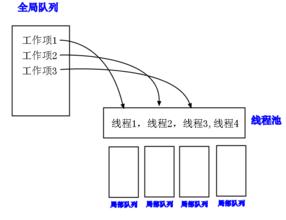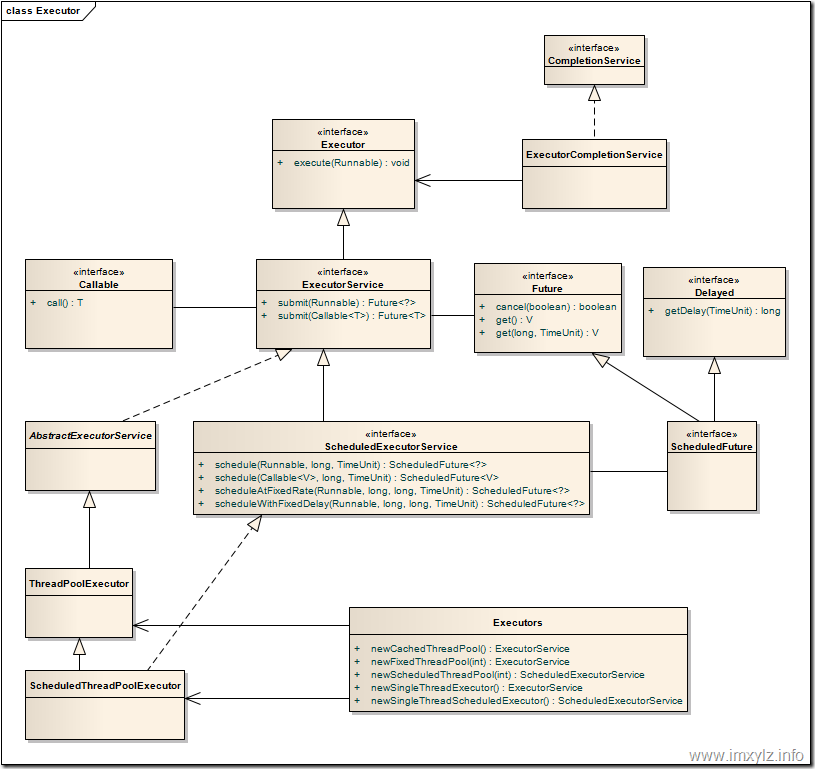java/android线程池详解
一,简述线程池:
线程池是如何工作的:一系列任务出现后,根据自己的线程池安排任务进行。
如图:

线程池的好处:
- 重用线程池中的线程,避免因为线程的创建和销毁所带来的性能开销。
- 能有效控制线程池的最大并发数,避免大量的线程之间因互相抢占系统资源而导致的阻塞现象。
- 能对线程进行简单的管理。并提供定时执行以及指定间隔循环执行等功能。
线程池的具体实现为ThreadPoolExeutor,其接口为Executor。
ThreadPoolExecutor提供了一系列的参数用于配置线程池。
public ThreadPoolExecutor(int corePoolSize, int maximumPoolSize, long keepAliveTime, TimeUnit unit, BlockingQueue<Runnable> workQueue, ThreadFactory threadFactory) { this(corePoolSize, maximumPoolSize, keepAliveTime, unit, workQueue, threadFactory, defaultHandler); }
参数含义如下:
- corePoolSize :线程池核心线程数,默认情况下,核心线程会在线程池中一直存活,即使他们处于闲置状态。其有一个allowCoreThreadTimeOut属性如果设置为true,那么核心线程池会有超时策略。超时的时长为第三个参数 keepAliveTime 。如果超时,核心线程会被终结。
- maxmumPoolSize: 线程池所能容忍的最大线程数,当活动线程数达到这个数值后,后续的新任务会被阻塞。
- keepAliveTime:非核心线程闲置时的超时时长,超过这个时长就会被非核心线程会被回收。这个参数如同第一个参数,如果设置相关属性后也会作用于核心线程。、
- unit:指定keepAliveTime的参数时间单位。这是一个枚举,常用的有MILLISECONDS(毫秒)、SECONDS(秒)等
- workQueue:线程池的任务队列,通过execute()方法(执行方法)提交的Runable对象会存储在这个参数中。
- threadFactory:线程工厂,为线程池提供创建新线程的功能。
其执行任务时大致遵顼如下规则:
- 如果线程达到核心线程数量,那么回直接启动一个核心线程。
- 线程未达到核心线程的数量,任务会被插入到任务队列(workQueue)排队。
- 如果任务队列已满导致步骤二无法插入到任务队列,那么开启一个非核心线程执行。
- 如果步骤三的线程数量达到线程池规定数目(maxmumPoolSize),那么拒绝执行此任务。
二,线程池的相关类结构解析
看一下线程池的类结构图:

说以下这几点:
这是一个抽象工厂模式!
Executor和Executors的区别:
Executor仅仅是一个接口,其只有一个方法,execute()方法(执行方法)。
public interface Executor { void execute(Runnable command); }
而Executors是一个没有继承任何类的方法,其作为一个工厂方法类,用于创建形形色色的线程池等对象。如:FixedThreadPool、defaultThreadFactory(下面会具体讲),而这些具体的线程池方案(FixedThreadPool)亦或者自定义的线程池方案(ThreadPoolExeutor)都是来自ExecutorService接口,这个接口也是继承于Executor接口。通过类结构图可以很清楚的看到。
如,Executors生产出ExecutorService对象,源码如下
public static ExecutorService newSingleThreadExecutor(ThreadFactory threadFactory) { return new FinalizableDelegatedExecutorService (new ThreadPoolExecutor(1, 1, 0L, TimeUnit.MILLISECONDS, new LinkedBlockingQueue<Runnable>(), threadFactory)); }
说到工厂模式,ThreadPoolExeutor的参数threadFactory是一个接口,仅有newThread方法,代码如下
public interface ThreadFactory { Thread newThread(Runnable r); }
其作用和executor接口类似,体现面向接口编程思想。其中例如如下两个方法,是工厂方法类Executors所生成的ThreadFactory对象。
public static ThreadFactory defaultThreadFactory() { return new DefaultThreadFactory(); } public static ThreadFactory privilegedThreadFactory() { return new PrivilegedThreadFactory(); }
defaultThreadFactory是这样创建线程的,如果要自定义不妨参照一下。
static class DefaultThreadFactory implements ThreadFactory { private static final AtomicInteger poolNumber = new AtomicInteger(1); private final ThreadGroup group; private final AtomicInteger threadNumber = new AtomicInteger(1); private final String namePrefix; DefaultThreadFactory() { SecurityManager s = System.getSecurityManager(); group = (s != null) ? s.getThreadGroup() : Thread.currentThread().getThreadGroup(); namePrefix = "pool-" + poolNumber.getAndIncrement() + "-thread-"; } public Thread newThread(Runnable r) { Thread t = new Thread(group, r, namePrefix + threadNumber.getAndIncrement(), 0); if (t.isDaemon()) t.setDaemon(false); if (t.getPriority() != Thread.NORM_PRIORITY) t.setPriority(Thread.NORM_PRIORITY); return t; } }
三 具体线程池的使用
说了那么多,要具体看看系统提供的线程池,主要是这四个:
- FixedTreadPool. fixed有稳固的含义,通过工厂方法类Executors的newFixedThreadPool方法创建。它是线程数量固定的线程池,仅有核心线程且没有超时策略,所以线程不会被回收。这意味着它能够快速的响应外界请求。
例子:这里设置了4个runnable和2个核心线程。
Runnable runnable = new Runnable() { @Override public void run() { Log.d("hello","sleep前"); SystemClock.sleep(3000); Log.d("hello", "sleep后"); } }; ...... ExecutorService executorService = Executors.newFixedThreadPool(2); executorService.execute(runnable); executorService.execute(runable1); executorService.execute(runable2); executorService.execute(runable3);
输出如下,
06-24 15:49:47.962 12462-12497/? D/hello: sleep1前 06-24 15:49:47.962 12462-12496/? D/hello: sleep前 06-24 15:49:50.962 12462-12497/com.example.hang.myapplication D/hello: sleep1后 06-24 15:49:50.962 12462-12497/com.example.hang.myapplication D/hello: sleep2前 06-24 15:49:50.972 12462-12496/com.example.hang.myapplication D/hello: sleep后 06-24 15:49:50.972 12462-12496/com.example.hang.myapplication D/hello: sleep3前 06-24 15:49:53.962 12462-12497/com.example.hang.myapplication D/hello: sleep2后 06-24 15:49:53.972 12462-12496/com.example.hang.myapplication D/hello: sleep3后
可以看到,每次仅有两个线程去执行,当其中一个执行完毕后才轮到下一个。
当 核心线程数量改为 4 时,则会一次性执行完这4个runnable。
- CachedThreadPool.它是一种线程数量不定的线程池,只有非核心线程,可以简单理解为最大线程数是无限大的。CachedThreadPool的任务队列相当于一个空集合,这导致任何任务都会被立即执行,比较适合做一些大量的耗时较少的任务。
例子,修改为将上述的 ExecutorService executorService = Executors.newFixedThreadPool(2);替换为
ExecutorService executorService = Executors.newCachedThreadPool();,输出如下,一次性执行4个线程,且线程顺序不定。
06-24 15:53:08.582 16801-16873/com.example.hang.myapplication D/hello: sleep2前 06-24 15:53:08.582 16801-16872/com.example.hang.myapplication D/hello: sleep1前 06-24 15:53:08.582 16801-16871/com.example.hang.myapplication D/hello: sleep前 06-24 15:53:08.582 16801-16875/com.example.hang.myapplication D/hello: sleep3前 06-24 15:53:11.582 16801-16873/com.example.hang.myapplication D/hello: sleep2后 06-24 15:53:11.582 16801-16872/com.example.hang.myapplication D/hello: sleep1后 06-24 15:53:11.582 16801-16871/com.example.hang.myapplication D/hello: sleep后 06-24 15:53:11.582 16801-16875/com.example.hang.myapplication D/hello: sleep3后
- ScheduledThreadPool.Scheduled有 “预定的” 意思。核心线程池的数量书固定的且非核心线程池是没有限制的,非核心线程池被闲置时会被立即回收。主要用于执行定时任务和具有固定周期的重复任务。
例子:这里是延迟2000ms后开始执行
ScheduledExecutorService scheduledExecutorService = Executors.newScheduledThreadPool(3); scheduledExecutorService.schedule(runnable,2000, TimeUnit.MILLISECONDS); scheduledExecutorService.schedule(runable1, 2000, TimeUnit.MILLISECONDS); scheduledExecutorService.schedule(runable2, 2000, TimeUnit.MILLISECONDS); scheduledExecutorService.schedule(runable3, 2000, TimeUnit.MILLISECONDS);
例子:延迟10ms后开始每1000ms执行一次runnable。
scheduledExecutorService.scheduleAtFixedRate(runnable,10,1000,TimeUnit.MILLISECONDS);
- SingleThreadExecutor.只有一个核心线程,所以确保所有的任务都是在一个线程里顺序执行。把所有的任务都放到一个线程,这样有一个好处是不需要处理线程同步问题。
这里就不做例子了,就是4个排着队依次执行,且不会乱序。
06-24 16:05:02.782 32057-32125/com.example.hang.myapplication D/hello: sleep前 06-24 16:05:05.782 32057-32125/com.example.hang.myapplication D/hello: sleep后 06-24 16:05:05.782 32057-32125/com.example.hang.myapplication D/hello: sleep1前 06-24 16:05:08.782 32057-32125/com.example.hang.myapplication D/hello: sleep1后 06-24 16:05:08.782 32057-32125/com.example.hang.myapplication D/hello: sleep2前 06-24 16:05:11.782 32057-32125/com.example.hang.myapplication D/hello: sleep2后 06-24 16:05:11.782 32057-32125/com.example.hang.myapplication D/hello: sleep3前 06-24 16:05:14.782 32057-32125/com.example.hang.myapplication D/hello: sleep3后




